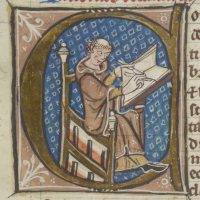Western Medieval Manuscripts
I wish that all of my books of civil law should remain in the common library of the scholars of the University of Cambridge forever…" The will of William Loring (d. 1416)

Though the precise origins of Cambridge University Library are not recorded, we know from the above declaration that a shared collection of books was in place for members of the University by at least 1416. Established before the invention of printing, the Library's earliest collections comprised entirely handwritten books. A small number of these survived dispersal or loss during the Reformation and have remained in the Library ever since. The modern foundations of the collection of western medieval manuscripts were laid later in the 16th century, and it grew through gift, bequest and purchase over subsequent centuries.
What began simply as a working collection thereby evolved into one of the most important repositories of evidence of the literate, artistic and intellectual culture of medieval Europe – a collection that remains of immense significance for study and for research. Cambridge University Library now holds over 2,000 handwritten books, as well as numerous rolls and documents, which altogether range in date from the 4th to the 16th centuries. A selection are shown here – including some of the Library's greatest treasures – and further additions will be made through ongoing and future digitisation and cataloguing projects.
The earliest manuscript in the collection is a bilingual copy of the New Testament and Acts of the Apostles in Latin and Greek, known in modern times as Codex Bezae. The majority of texts in the Library's manuscripts are written in Latin, however every major medieval vernacular language is represented. The University Library holds copies of several texts wholly or in part in Old English, the language written and spoken in England prior to the Norman Conquest, including a bilingual copy of the Psalms. Important pre-Conquest Latin manuscripts include the oldest datable copy of Bede's Historia ecclesiastica, made in the late 730s; the Book of Cerne, a devotional compilation made in Mercia in the mid-9th century; and a late 9th- or 10th-century pocket-sized Gospel book known as the Book of Deer, perhaps the oldest surviving manuscript that was made in Scotland. Middle English manuscripts are especially numerous, and include the earliest extant anthology of Geoffrey Chaucer's literary works, poems found in no other surviving manuscripts, and a great variety of manuscripts that contain medical recipes.
Many of the manuscripts are decorated and some are richly illuminated: highlights include two 13th-century bestiaries (MS Ii.4.26 and MS Kk.4.25); the only copy of a Life of St Edward the Confessor, perhaps authored by Matthew Paris, and made in the mid-13th century; a 14th-century breviary owned by Marie de Saint-Pol, founder of Pembroke College; and a guide to a healthy life and diet once owned by Henry VII and Elizabeth of York.
Several recent acquisitions are included here: a very early copy of a Latin translation of an Arabic medical text that was perhaps owned by Clare College in the late 14th century; two 15th-century compilations of medical recipes written in Middle English (MS Add. 9308 and MS Add. 9309); and a roll made in the late 13th century that lists the tenants and rents from properties owned by the Augustinian Priory of Holy Trinity in Ipswich.


